As a renter, you’re likely no stranger to the constraints of small spaces, but that doesn’t mean you can’t bring some greenery into your life.
You might be surprised at how easily you can grow your own herbs, veggies, or flowers, even without a yard.
With a little creativity, you can turn any corner of your apartment into a thriving oasis.
From clever container arrangements to space-saving vertical gardens, there are countless ways to get started – and we’re about to explore them.
So, what’s holding you back from turning your rental into a lush retreat?
Container Gardening 101
As you step out into your backyard or balcony, envision a vibrant oasis flourishing in containers, where petunias cascade down terra cotta pots and herbs thrive in wooden planters.
To bring this vision to life, you’ll need to make some key decisions. First, consider your container choices. Will you opt for sleek, modern planters or rustic, earthy ones? Think about the style you’re aiming for and the plants you want to feature. Terra cotta pots, wooden planters, and ceramic containers are all great options.
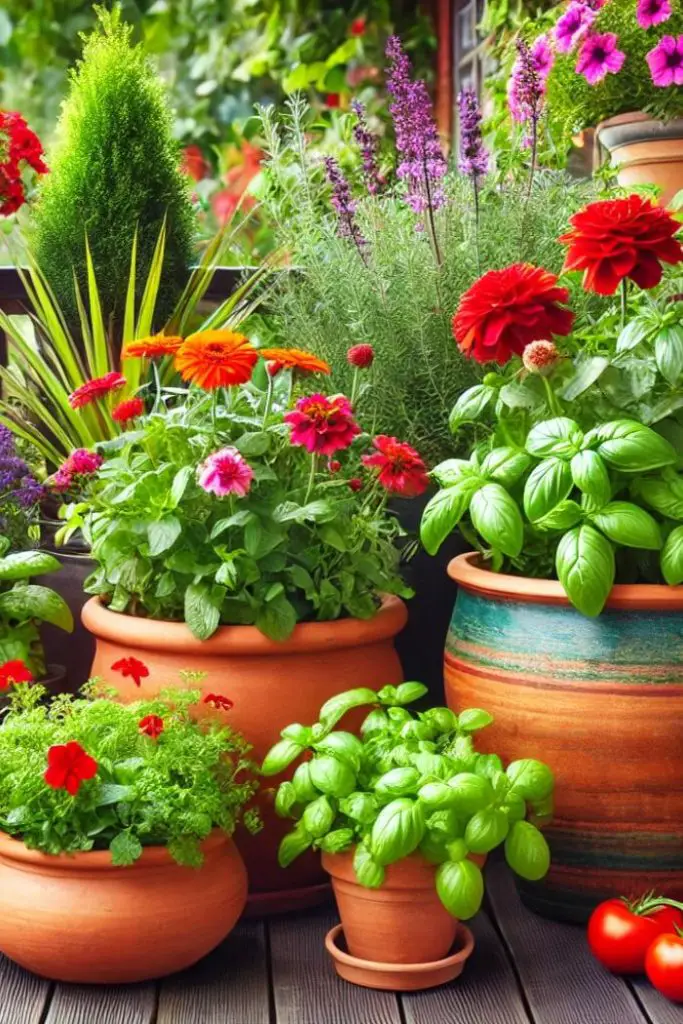
Next, it’s time to think about soil preparation. You’ll want a well-draining potting mix that’s specifically designed for containers. Look for a mix that contains peat moss, vermiculite, or perlite to guarantee your plants get the right amount of moisture.
Avoid using soil from your garden, as it can compact and prevent proper drainage. With the right container and soil, you’ll be well on your way to creating a thriving container garden that brings joy and beauty to your outdoor space.
Window Box Wonders
As you envision your window box wonder, you’re probably thinking about which vibrant flowers or lush greens will spill out of the box and catch the eye.
You’ll want to choose plants that thrive in containers and can tolerate the sunlight and temperature fluctuations of your windowsill.
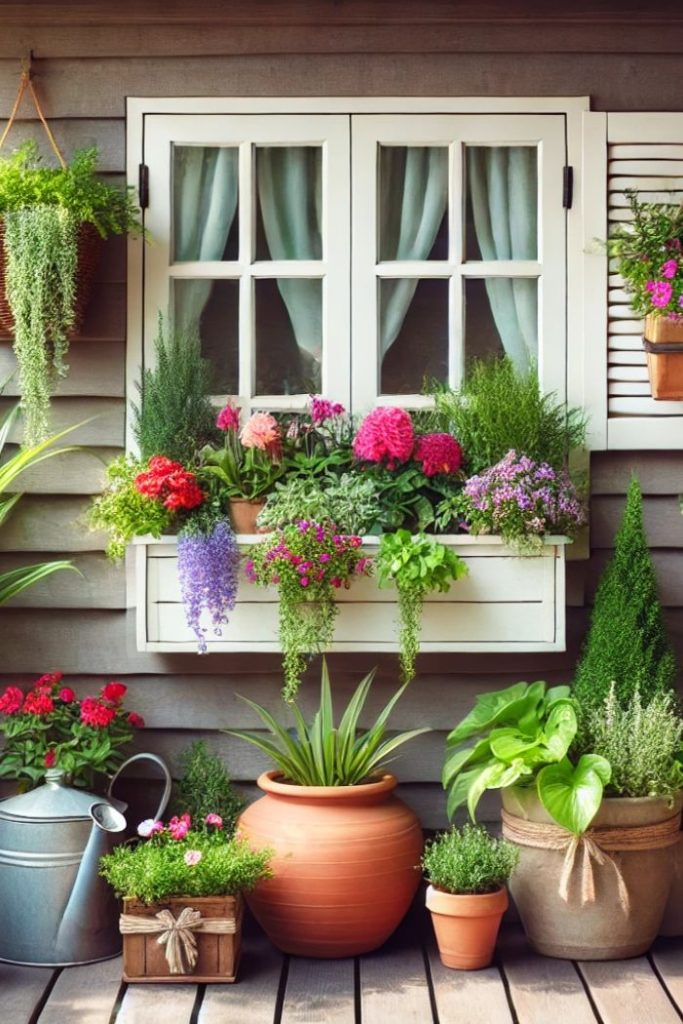
Plant Selection Tips
When choosing plants for your window box wonders, select a mix of thriller, filler, and spiller varieties to create a visually appealing display that cascades beautifully over the edges.
Thrillers are statement plants like bold flowers or dramatic foliage that draw the eye.
Fillers like sweet alyssum or creeping thyme provide a lush base, while spillers like ivy or petunias dangle elegantly over the sides.
Before selecting your plants, do your research.
Conduct soil testing to determine your window box’s pH levels and nutrient content.
This will help you choose plants that thrive in those conditions.
Climate research is also vital, as it will help you select plants that can withstand the temperature fluctuations and sunlight exposure of your window.
Consider plants with similar growing conditions and mature sizes to guarantee a harmonious display.
DIY Box Construction
With a few simple tools and some creativity, you can craft your own window box wonders, tailored to your unique space and style.
Start by selecting the perfect wood for your DIY project – cedar or reclaimed wood adds a rustic charm, while painted wood can match your home’s exterior. Cut the wood into the desired shape and size, guaranteeing a snug fit for your windowsill.
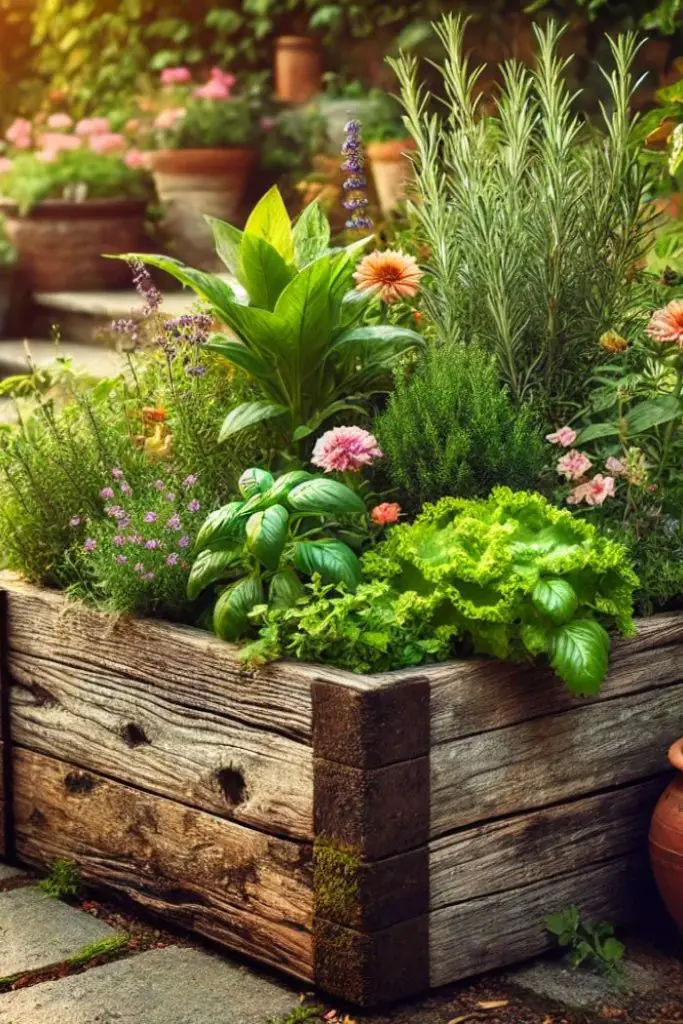
Add wooden corners for a polished finish and attach decorative lids to conceal the soil and add a touch of elegance. You can also add a trellis or a lattice design to provide support for climbing plants.
Next, add a waterproof lining to prevent moisture damage and promote healthy plant growth. Fill the box with a mix of potting soil, compost, and perlite for ideal drainage.
Space Maximization Tricks
By cleverly positioning your window box wonders, you can instantly create the illusion of more space, even in the coziest of rentals.
Imagine a lush greenery spilling over the edges of your window box, drawing the eye upwards and creating a sense of airiness.
To maximize space, consider investing in smart furniture with built-in planters or hidden shelves. This will allow you to tuck away pots and gardening tools, keeping your rental’s limited floor space clutter-free.

When choosing window boxes, opt for slim, wall-mounted designs that won’t obstruct your view or take up valuable floor space.
You can also repurpose existing furniture, such as an old dresser or bookshelf, to create a unique planter station.
Add some vertical greenery, like a trellis or a living wall, to further enhance the sense of openness.
By getting creative with your window box placement and cleverly utilizing every inch of space, you’ll be amazed at how much larger your rental can feel.
Indoor Herb Gardens

As you envision your indoor herb garden, you’re likely picturing a lush, fragrant oasis that adds a touch of greenery to your kitchen.
To bring this vision to life, you’ll want to focus on the essentials, like choosing the right herbs and planters, and finding innovative ways to maximize your space.
Herb Garden Essentials
What’s the secret to coaxing fragrant freshness from your indoor herb garden, where sunlight is scarce and space is limited?
It starts with selecting the right herbs and pairing them wisely. Master herb pairing basics by combining complementary flavors and textures, like basil and mint, or rosemary and thyme.
This harmonious blend will elevate your cooking and add visual appeal to your garden.
When harvesting, pinch or cut off individual leaves or stems to encourage bushy growth and prevent legginess. For a continuous supply, harvest in the morning, after the dew has dried but before the heat sets in.
As you snip, imagine the aromatic flavors infusing your next culinary creation.
To take your indoor herb garden to the next level, incorporate decorative planters, trellises, or a living wall to add dimension and style.
With these herb garden essentials, you’ll be sipping fresh mint tea and savoring homemade pesto in no time!
Small Space Solutions
In the midst of a compact kitchen or cozy apartment, you can still cultivate a lush indoor herb garden, even with limited square footage, by employing space-saving strategies that make the most of every inch.
For small scale living, compact designs are key. Consider using a vertical herb garden, where plants are stacked on top of each other, maximizing wall space and minimizing floor clutter.
Alternatively, opt for a window sill planter, which utilizes the natural light pouring in from the window to nurture your herbs. You can also repurpose everyday items, like mason jars or tea tins, as mini planters, adding a touch of whimsy to your kitchen.
When selecting herbs, choose varieties that thrive in indoor conditions, such as basil, mint, and parsley. By embracing these space-saving solutions, you can enjoy the benefits of fresh, fragrant herbs, even in the most compact of spaces.
With a little creativity, your small kitchen can become a thriving oasis, perfect for cooking up a storm.
Easy to Maintain
By choosing low-fuss herbs and implementing a few simple care habits, you can effortlessly maintain a lush and thriving indoor herb garden that’s always ready to flavor up your culinary creations.
Opt for low maintenance plants like basil, mint, and parsley, which require minimal pruning and can thrive in small pots.
To keep your indoor herb garden thriving, establish simple routines like watering once a week and providing indirect sunlight for 4-6 hours a day. Rotate your pots every few days to guarantee even growth and prevent leaning.
For an added touch, incorporate visually appealing planters and decorative stones to add texture and color to your space.
With these easy-to-follow tips, you’ll be enjoying fresh, fragrant herbs in no time. Plus, the aromatic scents will fill your kitchen, inspiring you to get creative with new recipes and flavor combinations.
Your indoor herb garden will become a staple in your kitchen, providing endless culinary possibilities.
Vertical Gardening Solutions
Transform your outdoor or indoor space into a lush oasis by utilizing wall-mounted planters, trellises, and living walls that maximize vertical real estate and add a touch of greenery to your life.
With wall gardens, you can create a stunning display of plants that seem to defy gravity, adding a unique touch to your space.
Vertical planters are perfect for small areas, allowing you to grow a variety of plants without taking up too much floor space.
You can choose from a range of materials, such as wood, metal, or recycled plastic, to create a look that suits your style.
Plus, many vertical planters come with built-in irrigation systems, making it easy to care for your plants.
Imagine a living wall covered in lush greenery, adding a touch of serenity to your busy life.
With vertical gardening solutions, the possibilities are endless, and you can create a breathtaking display that’s sure to impress.
DIY Trellis Ideas
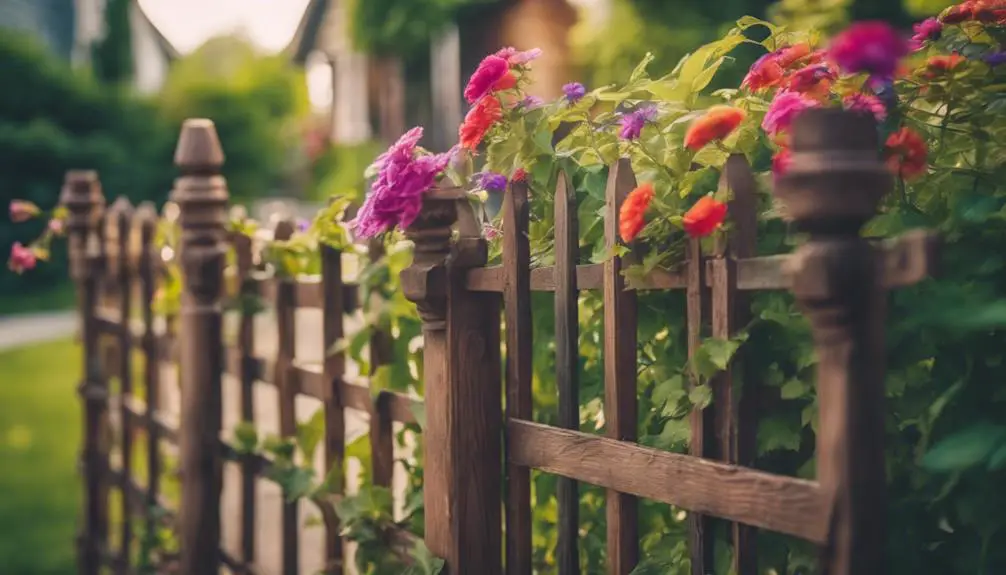
You can add a personal touch to your garden with a DIY trellis, crafting a unique support system that showcases your climbing plants in a beautiful, whimsical way.
By repurposing materials like old garden gates, wooden dowels, or even metal rods, you can create a one-of-a-kind trellis that adds visual interest to your outdoor space.
For a touch of sophistication, incorporate copper accents into your design. Copper wire or copper-plated planters can add a warm, metallic glow to your trellis, making it a stunning focal point in your garden.
To create a more rustic look, try using reclaimed wood or twine to craft a trellis that blends seamlessly into your garden’s natural surroundings.
You can also experiment with different shapes and patterns, like a geometric lattice or a whimsical spiral design.
Whatever your style, a DIY trellis is a great way to add personality to your garden without breaking the bank.
With a little creativity and some basic materials, you can create a beautiful, functional trellis that showcases your climbing plants in a unique and enchanting way.
Balcony Gardening Essentials
Vibrant blooms and lush greenery can thrive in even the smallest of outdoor spaces, as long as you’ve got the right balcony gardening essentials to bring your miniature oasis to life.
To get started, you’ll need a few key components: a sturdy railing planter or hanging basket, a trellis for climbing plants, and a self-watering pot to guarantee your plants stay hydrated.
Don’t forget to add some balcony decor to create a cozy ambiance – a few colorful throw pillows, a small outdoor rug, and some string lights can work wonders.
When choosing your balcony theme, consider the style of your home and the amount of sunlight your balcony receives. For a modern look, opt for sleek, geometric planters and a monochromatic color scheme.
If your balcony gets partial shade, a whimsical, bohemian theme with flowing vines and pastel hues might be more suitable.
With these balcony gardening essentials, you’ll be well on your way to creating a stunning outdoor retreat that’s perfect for relaxing and entertaining.
Microgreens for Small Spaces

As you’ve perfected your balcony oasis, now’s the time to explore the world of microgreens, where even the tiniest spaces can yield a bounty of nutrient-dense, visually stunning greens.
Imagine a windowsill bursting with vibrant, emerald-green pea shoots, or a compact planter overflowing with delicate, crimson-tinged radish greens.
Microgreens offer an incredible opportunity to add a pop of color and freshness to your small space, with varieties like spicy mustard, tangy arugula, and peppery cress to choose from.
Not only do microgreens add a visual punch, but they’re also packed with nutrition.
In fact, microgreen nutrition has been shown to be up to 40 times higher than their mature counterparts!
They’re rich in vitamins, minerals, and antioxidants, making them the perfect addition to salads, sandwiches, and smoothies.
Plus, they’re incredibly easy to grow, requiring minimal space, water, and maintenance.
With a little creativity, you can turn even the smallest of spaces into a thriving microgreen garden, and reap the rewards of fresh, healthy produce right in your own home.
Self-Watering Planters
Innovative self-watering planters bring freedom from daily watering duties, allowing your green thumb to flourish in even the busiest of schedules.
With built-in watering systems, these planters guarantee your plants receive the right amount of moisture, eliminating the risk of overwatering or underwatering.
You can choose from a variety of planter materials, such as sleek ceramic, durable plastic, or eco-friendly wood, to fit your personal style and space.
These clever planters often feature a hidden water reservoir, which slowly releases water as the soil needs it.
This means you can enjoy a worry-free vacation or simply focus on other tasks without worrying about your plants drying out.
Some self-watering planters even come with built-in sensors that monitor the soil’s moisture levels, sending you notifications when it’s time to refill the reservoir.
With self-watering planters, you can create a thriving indoor garden that requires minimal maintenance, yet still yields bountiful harvests.
Perfect for renters, these innovative planters let you bring the joy of gardening into your space, no matter how small or busy your schedule may be.
Upcycled Plant Containers
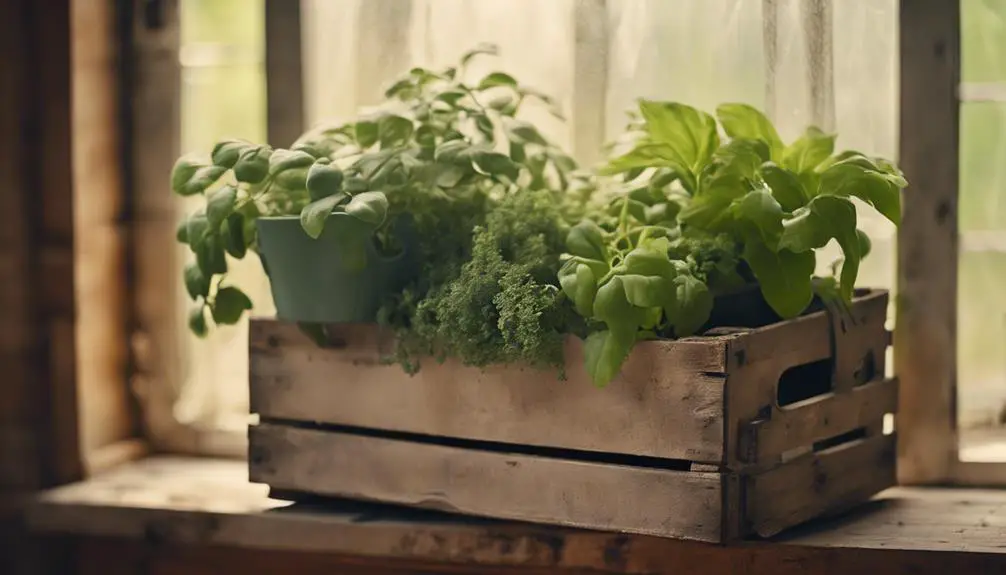
As you explore the world of upcycled plant containers, you’ll discover a treasure trove of old-to-new creations that will elevate your home garden’s style.
By repurposing items like vintage boots, tea cups, and wooden crates, you’ll create unique space savers that add a touch of whimsy to your outdoor space.
With a little creativity, you can turn discarded items into functional planters that showcase your personality and add visual interest to your garden.
Old to New Creations
You’ll be amazed at how easily you can transform discarded items like old boots, vintage suitcases, and worn-out tools into unique and functional plant containers that add a touch of whimsy to your garden.
These upcycled creations not only reduce waste but also infuse your outdoor space with personality and charm.
Visit flea markets or scour your grandparents’ attics for vintage planters, like distressed wooden crates or retro metal buckets, that can be repurposed as planters.
A fresh coat of paint or a dash of decoupage can revive these flea market finds, giving them a new lease on life.
Imagine a delicate succulent sprouting from a worn leather boot or a burst of colorful flowers spilling out of a vintage suitcase.
The possibilities are endless, and the result is a one-of-a-kind garden that reflects your creativity and resourcefulness.
Unique Space Savers
By repurposing items like old pallets, ladder rungs, or even bicycle baskets, you can craft space-saving plant containers that not only add a touch of greenery to tight spots but also double as functional decor.
Imagine transforming a worn ladder into a tiered planter, showcasing vibrant flowers and lush greens in a narrow hallway or stairwell. Or, turn an old bicycle basket into a charming hanging basket, suspended from a balcony or porch ceiling, creating an urban oasis in the midst of a bustling city.
These unique space savers allow you to maximize your renter’s space while injecting personality into your decor. Consider upcycling wooden crates into wall-mounted planters or using metal colanders as quirky hanging baskets.
The possibilities are endless, and the result is a visually stunning and eco-friendly way to bring some greenery into your life. By thinking outside the box (or planter), you can create a one-of-a-kind space that’s both beautiful and functional.
Indoor Lighting for Plants
Indoor Lighting for Plants
About 60% of indoor plants thrive under bright, indirect light, which can be achieved by placing them near an east- or west-facing window or using sheer curtains to filter intense sunlight.
But what if you don’t have a window with the perfect light? That’s where Light Therapy comes in. You can use specialized lamps that mimic the effects of Artificial Sunlight to give your plants the light they need.
These lamps are designed to provide the same spectrum and intensity of natural light, promoting healthy growth and development.
To get the most out of Light Therapy, place the lamp about 6-8 inches above your plants and adjust the timer to provide 12-14 hours of light per day.
You can also experiment with different light colors, such as blue light for leafy greens or red light for blooming plants.
By harnessing the power of Artificial Sunlight, you can create a thriving indoor garden, even in the darkest of spaces.
With a little creativity and innovation, you can bring the outdoors in and enjoy the beauty and benefits of indoor plants all year round.
Space-Saving Gardening Tips
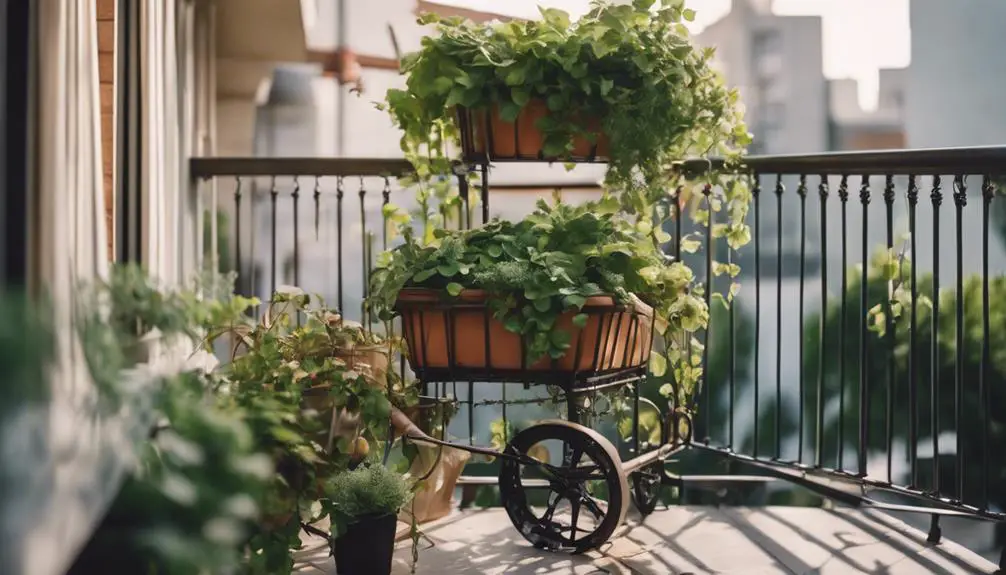
As you bring in the benefits of Artificial Sunlight, now it’s time to maximize your indoor gardening space, even in the smallest of areas, like balconies, patios, or tiny apartments, where every square inch counts.
To optimize your Garden Layout, consider a vertical approach. Install a trellis or a living wall to train vining plants like ivy or clematis to grow upwards, making the most of your ceiling height.
Utilize corners by placing triangular planters or corner shelves to hold smaller pots or herbs. Make the most of your walls by mounting planters or a window box to add more greenery without taking up floor space.
For efficient Space Utilization, choose compact or dwarf varieties of plants that won’t outgrow their containers. Group plants with similar light and watering requirements together to simplify care.
Patio Gardening on a Budget
With a dash of creativity and resourcefulness, you can transform your patio into a vibrant oasis without breaking the bank, repurposing items like old pallets, crates, and terracotta pots to create a unique and thriving garden space.
Upcycle an old pallet into a vertical planter, adding a touch of greenery to your patio decor. Use crates to create a tiered garden, perfect for showcasing a variety of plants and flowers.
For a pop of color, paint your terracotta pots in bold, bright hues. When it comes to budget hacks, think outside the box – or in this case, the pot.
Instead of buying expensive planters, use items you already have on hand, like old boots or tea cups, to add a touch of whimsy to your patio. You can also repurpose items like mason jars and wooden spoons to create a charming and rustic garden space.
With a little creativity, you can create a stunning patio garden on a budget that’s sure to impress!
Edible Gardening for Beginners
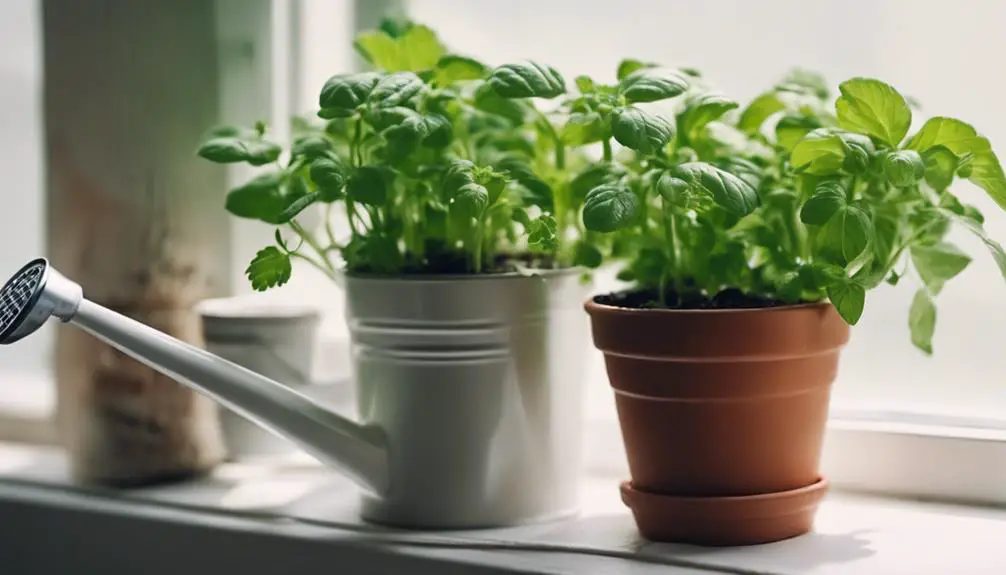
You step into your backyard, envisioning a lush haven where fresh, fragrant herbs and crisp, juicy vegetables await your culinary creations.
As a beginner in edible gardening, you’re enthusiastic to turn this vision into a reality. Start with a fresh start – clear the area of any debris and prep the soil for your new garden.
Set clear garden goals, like growing a specific type of herb or vegetable, to guide your efforts.
Begin with easy-to-grow plants like leafy greens, cherry tomatoes, or herbs like basil and cilantro.
Use containers or raised beds to create a defined space for your garden.
As you work the soil and plant your seeds, imagine the flavors and textures they’ll bring to your meals.
With each new sprout, you’ll be one step closer to harvesting the fruits of your labor.
Frequently Asked Questions
Can I Sublease My Garden Space to Another Renter?
You’re considering subleasing your garden space to another renter, but first, review your leasing agreement for limitations on garden sharing. Verify you’re not violating any terms, then get creative with a garden-sharing arrangement that benefits both parties.
How Do I Handle Pest Control Without Upsetting My Landlord?
When tackling pest control, you’ll want to get creative! Opt for visually appealing pest deterrents like copper tape or crushed eggshells, and explore organic methods like neem oil or basil plants to keep unwanted critters at bay without raising your landlord’s concerns.
Are There Any Gardening Activities That Violate Typical Renter Agreements?
As you dig in, remember to review your lease for garden rules and lease limitations. You’ll want to avoid activities that might violate your agreement, such as digging up the yard or installing permanent fixtures without permission.
Can I Install a Permanent Garden Feature Without Permission?
Before you start digging, check your lease limitations – you don’t want to violate garden restrictions. Without permission, installing a permanent feature can lead to penalties or even eviction, so verifying landlord approval beforehand is crucial.
How Do I Ensure My Garden Doesn’t Damage the Rental Property?
‘Before digging in, review your rental restrictions and Landlord agreements to guarantee you’re not breaking any rules. Take photos and notes to document your garden’s progress, and choose removable, non-invasive features to avoid damaging the property.’
Conclusion
As you gaze around your rented space, imagine the pops of greenery, the fragrant herbs, and the vibrant blooms that can bring life to your walls, windows, and shelves.
With these home gardening ideas, you can create a lush oasis that’s uniquely yours, without needing a yard.
Get creative, repurpose, and optimize your space – and watch your indoor garden flourish!




